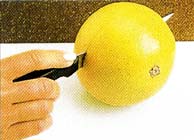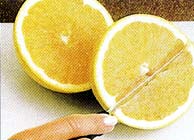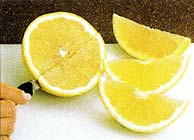|
Nutrition
In addition to providing grams and Daily Values, nutrient content
descriptors can inform consumers if a nutrient level is considered
high or low.
When using a nutrient content descriptor, Food and Drug Administration
labeling laws state that the descriptor should be used as in this
example: broccoli, a low-sodium food, or broccoli, low in sodium,
etc. The statement low-sodium broccoli implies that the broccoli
is different or specially prepared. Do not use that type of misleading
statement.
Nutrient content descriptors allowed for grapefruit include: fat-free,
saturated fat-free, sodium free, cholesterol-free, high in fiber,
a good source of vitamin A and high in vitamin C.
Foodservice
Halved or wedged grapefruit is popular anytime, but particularly
so at breakfast or on a salad bar. Halved grapefruits are just asking
for a topping. Top the sections with strawberries, brown sugar,
pepper rings or honey.
Grapefruit is good in drinks, fruit salads and salad dressing. It
also can be sautéed, made into jellies or marmalade. For
breakfast, layer grapefruit sections, strawberry yogurt and granola.
Juice squeezed from a fresh grapefruit makes tenderizing marinade
for any meat. Add shredded or grated grapefruit peel to sauces,
salad dressings, fruit compotes, a glass of wine or champagne or
decorate a sandwich tray or cake. For grapefruit shells, halve a
grapefruit crosswise. With a curved grapefruit knife or paring knife,
carve away the fruit inside. Scrape the shell clean with a spoon.
To prevent the shell from tipping, cut a thin slice from the bottom.
The shells are good for salads, cold soups, beverages, dips or sauces
and fruit compotes. Grapefruit can be cut into twists or smiles
for an appetizing garnish to any dish.
|
 1. Slice fruit in half as shown. (Do not cut through stem
1. Slice fruit in half as shown. (Do not cut through stem 2. Hold one half and slice diagonally to get three to
2. Hold one half and slice diagonally to get three to 3. Repeat with other half.
3. Repeat with other half.





